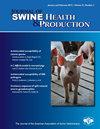猪肺炎支原体暴露的雾化技术作为适应策略的评估
IF 0.7
4区 农林科学
Q3 Agricultural and Biological Sciences
引用次数: 5
摘要
目的:本研究评估了雾化(NEB)(也称为雾化)在野外条件下暴露于猪肺炎支原体的效果,作为一种潜在的驯化策略。材料和方法:第一阶段由来自四个不同批次的母猪发育单元(GDU)的448只不含猪肺炎支原体的母猪组成。在研究第0天,第1批和第2批通过气管内(IT)途径暴露于猪肺炎支原体阳性肺匀浆,并用作第3批和第4批的参考,使用机械烟雾机暴露。在暴露后2周和4周(分别为D14和D28)采集气管支气管拭子(TBS),并通过合并样本的实时聚合酶链式反应评估感染成功率。在第二阶段,来自三个不同批次(5至7)的同一GDU的1160只母猪通过NEB暴露于猪肺炎支原体,并在D14采集TBS。结果:在第一阶段,在任何时间点(D14和D28),IT和NEB暴露在TBS合并样本的阳性比例和平均周期阈值方面没有观察到统计学上的显著差异。在第二阶段,来自所有批次的TBS合并样本在D14对猪肺炎支原体呈阳性。提示:雾化吸入猪肺炎支原体阳性的肺匀浆导致商业母猪感染该病原体。因此,在野外条件下,使用NEB可能是一种可靠的猪肺炎支原体暴露方法。这项调查中产生的信息拓宽了对这项技术作为一种适应策略的理解。本文章由计算机程序翻译,如有差异,请以英文原文为准。
Assessment of nebulization technology for gilt exposure to Mycoplasma hyopneumoniae as an acclimation strategy
Objective: This study assessed the efficacy of nebulization (NEB), also known as fogging, to expose gilts to Mycoplasma hyopneumoniae under field conditions as a potential acclimation strategy. Materials and methods: Phase I consisted of 448 M hyopneumoniae-free gilts from four different batches of a gilt development unit (GDU). On study day 0, batches 1 and 2 were exposed to M hyopneumoniae-positive lung homogenate via intratracheal (IT) route and were used as reference for batches 3 and 4, which were exposed using a mechanical fogger. Tracheobronchial swabs (TBS) were collected at 2 and 4 weeks post exposure (D14 and D28, respectively) and infection success was assessed by real-time polymerase chain reaction of pooled samples. In phase II, 1160 gilts from the same GDU belonging to three different batches (5 to 7) were exposed to M hyopneumoniae via NEB, and TBS were collected at D14. Results: In phase I, no statistically significant differences were observed between IT and NEB exposure in proportion of positives and mean cycle threshold values of TBS pooled samples at any time point (D14 and D28). In phase II, TBS pooled samples from all batches were positive for M hyopneumoniae at D14. Implications: Nebulization of lung homogenate positive for M hyopneumoniae resulted in infection of commercial gilts with this pathogen. Therefore, the use of NEB may be a reliable M hyopneumoniae exposure method under field conditions. The information generated in this investigation broadens the understanding of this technology as an acclimation strategy.
求助全文
通过发布文献求助,成功后即可免费获取论文全文。
去求助
来源期刊
CiteScore
1.80
自引率
0.00%
发文量
29
审稿时长
>36 weeks
期刊介绍:
The Journal of Swine Health & Production (JSHAP) is an open-access and peer-reviewed journal published by the American Association of Swine Veterinarians (AASV) since 1993. The aim of the journal is the timely publication of peer-reviewed papers with a scope that encompasses the many domains of applied swine health and production, including the diagnosis, treatment, management, prevention and eradication of swine diseases, welfare & behavior, nutrition, public health, epidemiology, food safety, biosecurity, pharmaceuticals, antimicrobial use and resistance, reproduction, growth, systems flow, economics, and facility design. The journal provides a platform for researchers, veterinary practitioners, academics, and students to share their work with an international audience. The journal publishes information that contains an applied and practical focus and presents scientific information that is accessible to the busy veterinary practitioner as well as to the research and academic community. Hence, manuscripts with an applied focus are considered for publication, and the journal publishes original research, brief communications, case reports/series, literature reviews, commentaries, diagnostic notes, production tools, and practice tips. All manuscripts submitted to the Journal of Swine Health & Production are peer-reviewed.

 求助内容:
求助内容: 应助结果提醒方式:
应助结果提醒方式:


